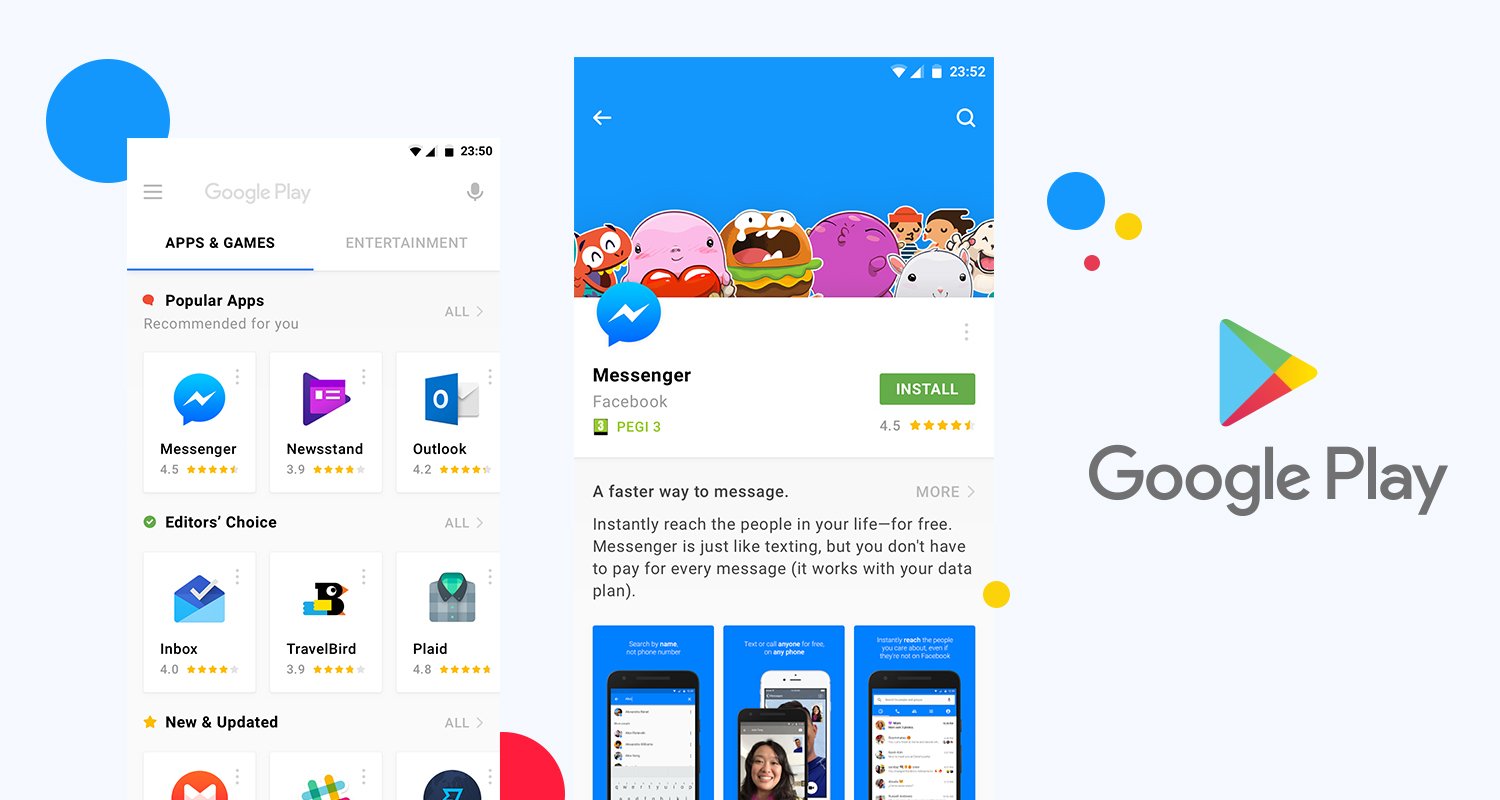In today's mobile-first world, mastering mobile ad targeting has become essential for businesses seeking to reach and engage their target audience effectively and maximize the return on their advertising investment.
Related posts
How to increase Google Play downloads and installs free
Best ways to promote dating apps on Google Play and App Store effectively
1. Define Your Target Audience of mobile ad targeting
Defining your target audience is the crucial first step in mobile ad targeting. Your target audience is the group of people who are most likely to be interested in your product or service and who are most likely to take the desired action (such as making a purchase or installing your app) after seeing your mobile ad.
To define your target audience for mobile ad targeting, consider the following factors:
Demographics: Age, gender, income, education, occupation, marital status, and other relevant demographic information that can help you understand your potential customers.
Psychographics: Interests, hobbies, values, lifestyle, and other factors that can help you understand your target audience's attitudes and behaviors.
Location: Where your target audience is located, such as specific cities, regions, or countries. This is particularly important if you are a local business or if you want to target users in specific regions.

Define Your Target Audience of mobile ad targeting, Source: asoservice.com
Behavior: What your target audience does online, such as the websites they visit, the apps they use, and the actions they take on their mobile devices.
Device: The type of mobile device your target audience uses, such as iPhone, Android, tablet, or other devices.
By considering these factors, you can create a customer persona or a detailed description of your ideal customer. This can help you tailor your mobile ad campaigns; to reach the right audience and improve the effectiveness of your ads.
2. Choose the Right Mobile Ad Formats for Mobile Ad Targeting
Mobile advertising has become an essential part of digital marketing; and it has evolved significantly over the years. Today, mobile ad targeting is more refined; and advertisers have a wide range of ad formats to choose from. Choosing the right mobile ad format is critical to the success of your campaign. Here are some of the most popular mobile ad formats:
Native Ads: Native ads blend in with the content on the page and are designed to look like a natural part of the user experience. They are less intrusive and have a higher engagement rate than other ad formats.
Video Ads: Video ads are engaging and can convey a lot of information in a short time. They can be in-stream, where the ad plays before, during, or after the video content, or out-stream, where the video ad appears in between the content.
Banner Ads: Banner ads are the most common type of mobile ad format. They are small, rectangular ads that appear at the top or bottom of the screen. They can be static or animated.
Interstitial Ads: Interstitial ads are full-screen ads that appear between content. They are a great way to capture the user's attention, but they can be intrusive and disrupt the user experience.
Rich Media Ads: Rich media ads are interactive ads that use features like video, audio, and animations. They are engaging and can increase the time users spend interacting with the ad.
In-App Ads: In-app ads appear within mobile apps. They can be banners, interstitials, or native ads. In-app ads are a great way to reach a targeted audience; because they are relevant to the app's content.
Choosing the right mobile ad format depends on your advertising goals, target audience, and budget. Native and video ads are great for engagement and brand awareness; while banner and interstitial ads are better for direct response. You can buy Android app reviews to increase the trust for your app from asoservice.com.
3. Leverage Mobile Ad Networks and Platforms
Mobile ad networks and platforms are essential tools for mobile ad targeting, allowing advertisers to reach a large number of users across multiple apps and websites. These networks and platforms offer a range of targeting options, ad formats, and measurement tools, making it easier for advertisers to create effective mobile ad campaigns. Here are some ways to leverage mobile ad networks and platforms for mobile ad targeting:
Audience Targeting: Mobile ad networks and platforms allow advertisers to target specific audiences based on demographics, interests, behaviors, and location.
Ad Format: Mobile ad networks and platforms offer a range of ad formats, including native ads, video ads, interstitial ads, and banner ads. Advertisers can choose the ad format that best suits their campaign objectives and target audience.
Performance Measurement: Mobile ad networks and platforms provide performance measurement tools; that allow advertisers to track their ad campaigns' success. They can measure metrics such as impressions, clicks, conversions, and return on investment (ROI).
Programmatic Advertising: Programmatic advertising is an automated way of buying and selling digital ad inventory. Mobile ad networks and platforms offer programmatic advertising; which allows advertisers to reach their target audience across multiple apps and websites in real time.
Ad Fraud Prevention: Mobile ad networks and platforms have sophisticated fraud prevention tools to protect advertisers; from fraudulent traffic and invalid clicks. These tools ensure that advertisers only pay for legitimate clicks and impressions.
In summary, mobile ad networks and platforms offer advertisers a range of targeting options; ad formats, performance measurement tools; programmatic advertising, and ad fraud prevention. By leveraging these tools; advertisers can create effective mobile ad campaigns that reach the right audience and achieve their campaign objectives.
4. Incorporate Data and Analytics of Mobile Ad Targeting
Mobile ad targeting involves using data and analytics to identify and reach the most relevant audience for a particular ad campaign. The process typically involves collecting and analyzing a variety of data points; related to mobile device usage and user behavior, such as location; browsing history, search terms, and app usage.
One key aspect of mobile ad targeting is the use of machine learning algorithms; to analyze large volumes of data and identify patterns and insights that can be used to optimize ASO. For example, these algorithms can analyze user data to identify demographic and behavioral characteristics; that are most likely to be associated with a particular product or service.
Another important aspect of mobile ad targeting is the use of data management platforms (DMPs) to collect; store, and analyze user data across multiple channels and devices. DMPs allow marketers to build detailed profiles of their target audience; and use this information to deliver more personalized and relevant ad experiences.
Finally, analytics tools are critical for measuring the effectiveness of mobile ad-targeting campaigns. These tools allow marketers to track key metrics; such as click-through rates, conversion rates, and engagement levels; and adjust their targeting strategies accordingly.
Overall, data and analytics play a critical role in the success of mobile ad targeting campaigns, helping marketers to reach the right audience with the right message at the right time.
5. Utilize Mobile App Advertising for Mobile Ad Targeting
Mobile app advertising is a type of mobile ad targeting that involves displaying ads within mobile applications. This approach can be particularly effective for reaching a highly engaged and specific audience, as users tend to spend a significant amount of time within apps and may have already expressed interest in a particular topic or product.
One way to implement mobile app advertising is through in-app ads, which can take a variety of forms, including banners, interstitials, and native ads. These ads can be targeted based on a range of factors, such as user demographics, interests, and behaviors, as well as contextual factors, such as the content of the app or the time of day.
To effectively utilize mobile app advertising, it is important to have a clear understanding of the target audience; and their behaviors within mobile apps. This may involve analyzing user data such as app usage patterns, purchase history, and search behavior. Machine learning algorithms can be used to analyze this data; and identify patterns and insights that can be used to optimize ad targeting.
In addition, it is important to track key metrics such as click-through rates; conversion rates, and engagement levels to measure the effectiveness of mobile app advertising campaigns; and adjust targeting strategies accordingly. By leveraging data and analytics; mobile app advertising can be a powerful tool; for reaching and engaging a specific and highly engaged audience. You can buy app reviews from real users.
6. Follow Mobile Ad Guidelines and Regulations
When developing and implementing mobile ad targeting campaigns; it is important to follow mobile ad guidelines; and regulations to ensure compliance with industry standards and legal requirements. Here are some key considerations to keep in mind:
Ad content: Ensure that all ad content is clear, truthful, and not misleading. Advertisers should also avoid using deceptive or offensive content.
User consent: Advertisers must obtain user consent before collecting or using any personal data for ad targeting purposes. This may involve providing clear information about data collection practices; and offering users the option to opt-out.
Appropriate targeting: Advertisers should avoid targeting ads to users who are not relevant or who have expressed a desire not to receive such ads. This may involve using appropriate targeting criteria such as demographics, interests, and behaviors.
Privacy policies: Advertisers should have clear privacy policies in place that outline how user data will be collected, used, and shared.
Industry standards: Advertisers should follow industry standards for ad placement and formatting, such as the Interactive Advertising Bureau's (IAB) Mobile Rich Media Ad Interface Definitions (MRAID) and Mobile Web Advertising Measurement Guidelines.
Legal requirements: Advertisers should ensure compliance with all relevant legal requirements, such as the General Data Protection Regulation (GDPR) in Europe and the California Consumer Privacy Act (CCPA) in the United States.
By following these guidelines and regulations, advertisers can ensure that their mobile ad targeting campaigns are effective, ethical, and compliant with industry standards and legal requirements.
Conclusion
By utilizing data and analytics, following industry guidelines and regulations, and implementing best practices for mobile ad targeting, businesses can create highly effective and efficient campaigns that engage their target audience, drive conversions, and help them achieve their marketing goals in the mobile landscape.
Related posts
https://asoservice.com/microsoft-store-app-reviews
https://asoservice.com/increase-app-installs-from-google-ads
Thanks so much for reading this article.
Source: https://asoservice.com/












Leave a Reply
Your e-mail address will not be published. Required fields are marked *